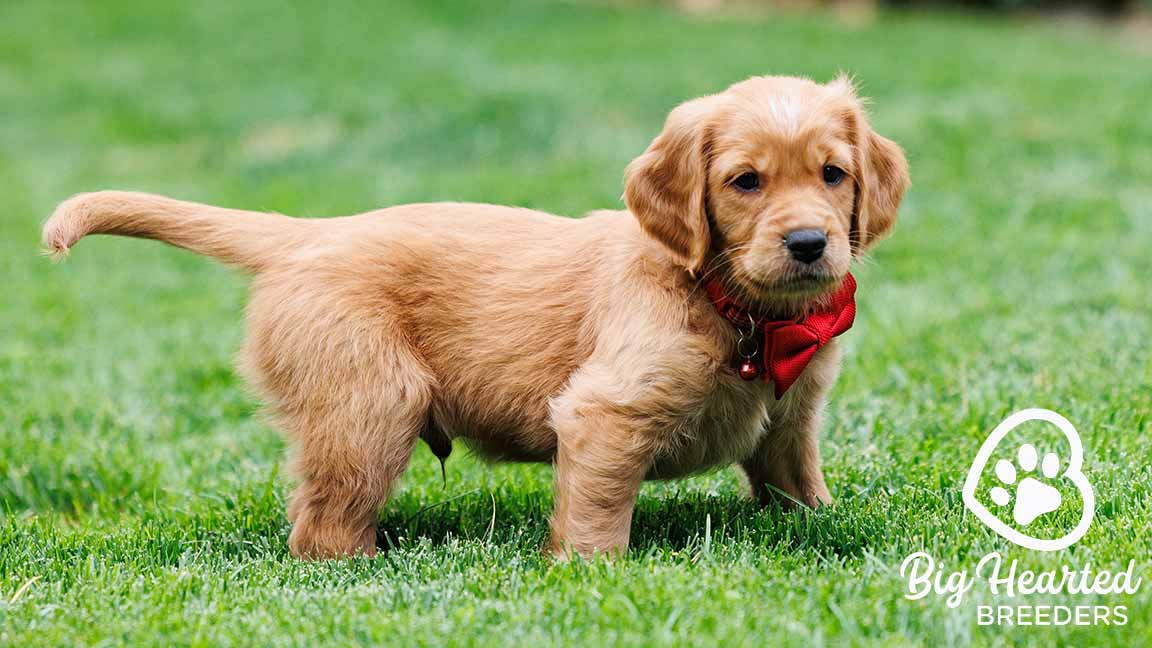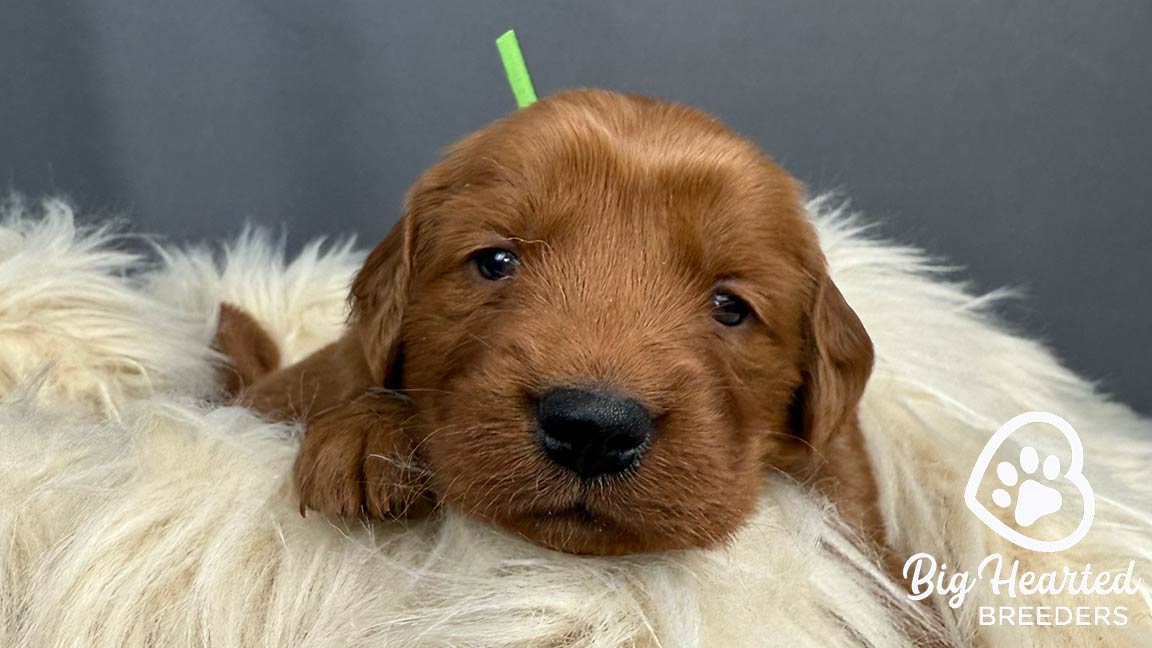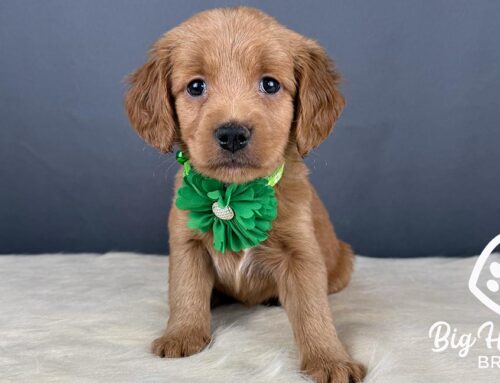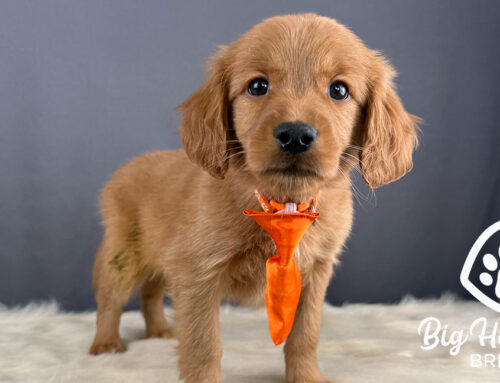How Long Does Puppy Teething Last: Complete Guide
How Long Does Puppy Teething Last: Complete Guide
It’s early Saturday morning, and your once-sweet pup is now chewing everything in sight. Their gums are red, they’re drooling like a faucet, and they seem downright miserable. Sound familiar? You’re not alone, we’ve taken many a frantic phone call from new puppy parents wondering, “Is this normal? How long does this puppy teething stage last?”
The short answer: puppy teething usually starts around 12 weeks and lasts until your pup is 6 to 7 months old. By the end of it, all 42 adult teeth should be in place, and you’ll both be breathing a sigh of relief.
But while this phase is temporary, it can feel intense. As longtime Mini Golden Retriever breeders, we’ve raised hundreds of puppies through this process. And here’s what we’ve learned: with a little knowledge and preparation, you can make puppy teething more comfortable for your puppy and a whole lot less stressful for you.

When Does Puppy Teething Start and End?
Puppies are born without teeth. Around 3 weeks of age, their first tiny baby teeth (also called “deciduous teeth”) begin to erupt. By 6 weeks, most puppies have a full set of 28 baby teeth, sharp little nippers that help them eat softened food and start exploring the world.
The real puppy teething drama kicks in between 12 and 16 weeks, when those baby teeth begin falling out to make room for permanent adult teeth. This second teething stage is what most new puppy owners notice. It comes with increased chewing, drooling, fussiness, and sometimes even a low appetite or mild bleeding.
Puppy teething typically winds down by 6 or 7 months, but smaller breeds like Mini Golden Retrievers may stretch into 8 months due to their jaw size. Don’t be surprised if your pup is still chewing like mad at 7 months, that’s perfectly normal.

What Are the Signs of Puppy Teething?
Puppies don’t come with warning labels, but the signs of teething are pretty easy to spot:
- Increased chewing – Furniture, shoes, toys, your hands—nothing is safe.
- Swollen, red gums – Teething can cause inflammation and visible gum discomfort.
- Bleeding gums or blood spots – You might notice some red on toys or bedding.
- Drooling – Some puppies drool more than usual when teething.
- Chewing and whining – If they’re gnawing constantly and seem irritated, puppy teething is likely to blame.
- Finding tiny teeth – Baby teeth may fall out while chewing or even get swallowed (totally fine).
- Appetite changes – Sore mouths can make eating less appealing, especially crunchy kibble.
Every puppy is different. Some breeze through it without a hiccup, while others are downright dramatic. The important thing is knowing what’s normal and being ready to help.
How Can You Help a Teething Puppy?

Your mission: soothe those sore gums and redirect all that chewing energy away from your baseboards.
Here are our top puppy teething survival tips:
- Provide safe, appropriate chew toys. Look for rubber or nylon toys designed for puppies. Avoid anything hard like bones or antlers, they can crack developing teeth.
- Use frozen treats. Frozen carrots, chilled fruit slices (no grapes!), and frozen puppy-safe teething rings can ease gum pain.
- Try a frozen washcloth. Twist a clean, damp cloth and freeze it. Puppies love the texture and cold relief.
- Offer soft or moistened food. If chewing is painful, soften kibble with warm water or mix in wet food for a few days.
- Massage their gums. Gently rubbing their gums with your finger can provide soothing relief and help desensitize them to future brushing.
- Stick to a routine. Even if puppy teething disrupts sleep or housetraining, consistency helps them feel secure.
Above all, be patient. Teething can make even the most well-behaved puppy act out. They’re not being “bad”; they’re just trying to cope.
Puppy Teething and Personality: Why It Varies
One thing we’ve learned over the years is that personality plays a big role in how a puppy handles teething. Some pups, like our sweet-natured boy Charlie, barely made a fuss. Others, like his sassy sister Penny, treated teething like the end of the world.
Confident puppies may quietly self-soothe with chew toys, while more sensitive ones seek comfort and cry when discomfort hits. Knowing your puppy’s temperament can help you respond with the right level of support, whether that’s extra snuggles or quiet time in their crate with a cold chew toy.

Does Breed or Size Make a Difference?
Absolutely. Mini Golden Retrievers, and other small breeds, tend to have a more compact jaw structure. This can mean:
- Less room for incoming teeth, increasing pressure and discomfort
- Slightly longer puppy teething timelines, some pups take up to 8 months to finish
- Higher sensitivity to pain or pressure
We often tell our puppy families to expect a slightly extended teething phase compared to standard Golden Retriever.. And that’s okay! As long as adult teeth are coming in and baby teeth are falling out, your pup is on track.
Set the Stage for Lifelong Dental Health
Puppy teething is a golden opportunity to build good habits. Start brushing now, just a few seconds at a time. Use a soft-bristled toothbrush or finger brush and puppy-safe toothpaste (never human toothpaste!).
Handling your puppy’s mouth regularly helps desensitize them to dental care and reduces future stress at the vet. Regular brushing plus yearly dental checks go a long way toward preventing plaque, tartar, and painful dental disease later in life.
When Should You Call the Vet?
Most puppy teething issues resolve on their own, but a few warning signs deserve professional attention:
- Your puppy hasn’t eaten in 24+ hours
- Their gums are oozing pus or bleeding heavily
- You see broken or fractured teeth
- Baby teeth aren’t falling out and seem to block adult teeth (retained baby teeth)
Your vet can help with stubborn teeth or check that everything is coming in correctly.

FAQ
How long does puppy teething last?
Typically between 12 weeks and 6 or 7 months. Some smaller breeds may finish closer to 8 months.
Is it normal for puppies to bleed while teething?
A little blood is totally normal. If you see blood on toys or bedding, don’t panic. Excessive bleeding, though, warrants a call to the vet.
What’s the best thing to give a teething puppy?
Frozen carrots, damp washcloths, puppy teething toys, or soft rubber chews. Avoid bones or anything hard enough to hurt.
My puppy’s not eating, should I worry?
Sore gums can make eating uncomfortable. Try softening their food. If they skip more than one meal or seem lethargic, check in with your vet.
Can I brush my puppy’s teeth during teething?
Yes, gently and gradually. Keep it short and positive. You’re building the foundation for healthy adult teeth.
Final Thoughts: This Too Shall Pass
Puppy teething may be a wild ride, but it’s also a sign your puppy is growing up. The chewing, drooling, and sleepless nights won’t last forever. With the right tools, a little patience, and a sense of humor, you’ll both make it through just fine.
And remember, you’re not doing this alone. At Big Hearted Breeders, we support our families every step of the way. Whether your puppy is happily chewing a toy or crying over sore gums, we’re just a phone call away.
This phase will pass, but the bond you build by supporting your puppy through it will last a lifetime.





